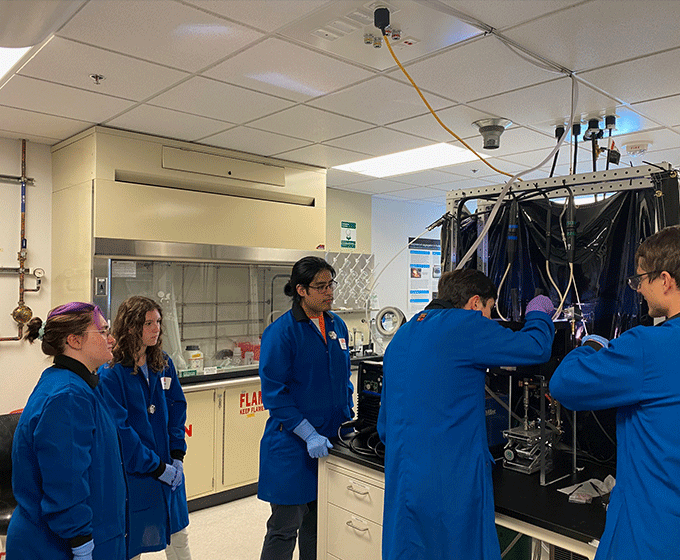
OCTOBER 2, 2024 — UTSA was selected by the U.S. Department of Energy’s (DOE) Office of Nuclear Energy (NE) to lead a multimillion-dollar project that will stimulate nuclear energy research at UTSA, leverage novel experimental data to bolster computational efforts at the university, and provide professional training to prepare undergraduate and graduate students for careers in nuclear energy science. UTSA researchers will collaborate with a leading nuclear energy laboratory as well as across academic institutions.
The award is part of the DOE’s Nuclear Energy University Program’s Integrated Research Projects (IRPs). These projects aim to provide research and development solutions that are relevant to the DOE. Each IRP is a three-year, multimillion-dollar project executed by university-led consortiums that typically include multiple universities, industry, national laboratories, and international research entities. IRPs are highly competitive, with only three FY 2024 Integrated Research (IRP) Projects being awarded by the DOE NE this year. As the lead institution, UTSA is designated to receive over half of the award, which is around $1.5 million of the $3 million award.
“This research will contribute to the knowledge base and understanding of novel nuclear fuels proposed to power advanced systems that will bring us all one step closer to achieving our clean energy and climate goals, while also advancing space exploration beyond our planet,” said Elizabeth Sooby, principal investigator on the project and associate professor in the UTSA Department of Physics and Astronomy.
The project is entitled, “Experimental and Computational assessment of thermodynamic stability of fission products in advanced reactor fuels.” UTSA will collaborate with the University of Texas at El Paso (UT El Paso) and Idaho National Laboratory (INL), a leading DOE NE national laboratory, to investigate fission product (FP) behavior in advanced reactor fuels.
Fission products (FPs) are particles that remain after nuclear fission, the process that occurs when a nucleus is split into two smaller nuclei to generate energy. This project will utilize experimental and computational methods to investigate FPs and their influence on the thermal and mechanical properties of advanced reactor fuels, specifically uranium mononitride (UN).
UN is a chemical compound that refers to an oxidation state where nitrogen binds to the fissile fuel-uranium. UN is known for its high uranium density as well as high thermal conductivity which results in more efficient power production and heat transfer.
Uranium nitrides are seen by the nuclear materials community as exciting candidate fuels for advanced nuclear systems, including space nuclear propulsion and advanced civilian power systems.
“Nuclear reactor developers all over the U.S. are proposing designs for safer, more economical, proliferation resistance systems,” added Sooby. “Many of these new technologies necessitate the use of nuclear fuels which are not yet on the market. Further, with the push to go to Mars, there’s a great deal of attention being placed on space nuclear power systems to both power habitats and space craft.”
Sooby has spent 15 years of her scholarly career dedicated to the materials science investigations of emerging materials for energy technologies. Since arriving at UTSA in 2017, Sooby has built and leads the Extreme Environments Materials Laboratory, which is bridging data gaps and advancing the fundamental understanding of uranium-bearing compounds that can be used as fuel forms for nuclear reactors.
This laboratory includes equipment that can synthesize, characterize and test these compounds safely under reactor-relevant conditions that encompass both normal operation and accident scenarios.
Sooby’s collaborators include Xochitl Lopez-Lozano and Patrick Warren, associate professor and assistant professor of research, respectively, in the university’s physics and astronomy department; Eunja Kim and Mark Pederson, professors in the Department of Physics at UT El Paso; Tiankai Yao, a staff scientist at the Characterization & Advanced PIE division of Materials and Fuel Complex at Idaho National Laboratory; and Mira Khair, a postdoctoral fellow in the UTSA Department of Physics and Astronomy. Additionally, the team will recruit two UTSA graduate students and over 15 undergraduates to assist with the project.
“We will combine our world-class capabilities with experimental expertise and experience in synthesis and testing of uranium compounds to advance the world’s understanding of fission product mobility in non-oxide fuels,” said Sooby. “This discovery will propel us forward by granting greater access to cleaner and more efficient forms of nuclear energy that will help us achieve our current climate and space propulsion goals.”
UTSA Today is produced by University Communications and Marketing, the official news source of The University of Texas at San Antonio. Send your feedback to news@utsa.edu. Keep up-to-date on UTSA news by visiting UTSA Today. Connect with UTSA online at Facebook, Twitter, Youtube and Instagram.
Move In To COLFA is strongly recommended for new students in COLFA. It gives you the chance to learn about the Student Success Center, campus resources and meet new friends!
Academic Classroom: Lecture Hall (MH 2.01.10,) McKinney Humanities BldgWe invite you to join us for Birds Up! Downtown, an exciting welcome back event designed to connect students with the different departments at the Downtown Campus. Students will have the opportunity to learn about some of the departments on campus, gain access to different resources, and collect some giveaways!
Bill Miller PlazaCome and celebrate this year's homecoming at the Downtown Campus with food, games, giveaways, music, and more. We look forward to seeing your Roadrunner Spirit!
Bill Miller PlazaThe University of Texas at San Antonio is dedicated to the advancement of knowledge through research and discovery, teaching and learning, community engagement and public service. As an institution of access and excellence, UTSA embraces multicultural traditions and serves as a center for intellectual and creative resources as well as a catalyst for socioeconomic development and the commercialization of intellectual property - for Texas, the nation and the world.
To be a premier public research university, providing access to educational excellence and preparing citizen leaders for the global environment.
We encourage an environment of dialogue and discovery, where integrity, excellence, respect, collaboration and innovation are fostered.